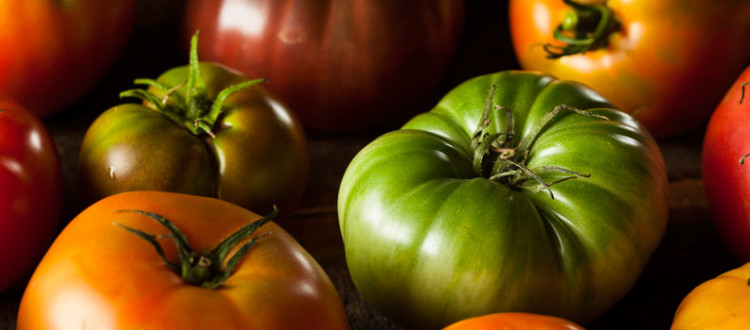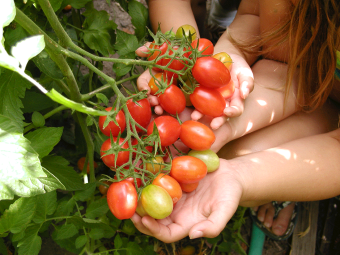Tomatoes
Tomatoes (Solanum lycopersicum) are members of the diverse nightshade (Solanaceae) family. Technically, the tomato is a fruit, but for culinary purposes it is treated as a vegetable. The U.S. Department of Agriculture (USDA) also considers it to be a vegetable.
Although the tomato originated in the Andes of South America, it was popularized as a food in Mexico. European explorers such as Columbus and Cortez helped spread this food to other continents, making it one of the most popular vegetables in the world.
Tomatoes come in a dizzying array of shapes, sizes and colors, and can be an annual plant in cooler climates or a perennial in areas with mild winters. Some tomato varieties can reach 10 feet in height and produce vine-like branches that are structurally weak. Stakes, trellises or wire cages are needed to support branches, especially once they begin producing fruit. Other varieties have been bred to be bush-like and more compact and can grow without additional support.
How to Plant
Tomatoes love sun and need at least six hours a day of direct sunlight. In hot climates, tomatoes benefit from light shade to help withstand extremely hot summer temperatures.
Tomatoes thrive in soil that is loose and crumbly to the touch. For best results, work the site where the tomatoes will be planted with a shovel or rototiller, incorporating mature compost and other organic material until it is evenly blended. Dig a hole deep enough to cover the root ball and the stalk up to the lowest leaves on the plant. It is a good idea to establish a stake next to the plant at the time of planting to avoid damaging the root ball once the plant is established.
Allow two to three feet between plants. If you’re not using stakes, give the plant and its vines enough room to spread out. Water generously until established, and then maintain watering on an regular schedule through the production season, about 2 inches per week. Irregular watering can result in split fruit.
Mulching the area at the base of the plant is recommended to help the soil retain moisture and reduce the incidence of weeds.
Tomatoes seem to attract bugs and diseases. Many gardeners use a “collar” made of newspaper, wrapped around the base of the plant to keep pests from attacking the leaves and fruit. A paper cup with the bottom cut out also works.
Fertilizing
After the plant is established and a couple of weeks before it begins producing fruit, fertile using a product specifically designed for tomatoes. Reapply two weeks after harvesting of fruits has begun.
Harvesting
Although there are a number of uses for immature, unripened fruit, fully ripe tomatoes have the most flavor. They will be firm to the touch and will turn a deep dark red — depending on the variety you’re growing.
Never refrigerate tomatoes. Temperatures below 55° cause flavor compounds to break down.
Recommendations for Use
Freshly harvested tomatoes provide a remarkably fresh flavor that tastes like summer itself. Tomatoes can be dried, canned or frozen, or can be transformed into sauces and salsas for off-season enjoyment.
For more tips about how to grow tomatoes, see 5 Steps for Growing Great Tomatoes.
Tomatoes
Edit the Tomatoes in the below Page Builder Section.
tomatoes
Leave a Reply
You must be logged in to post a comment.


